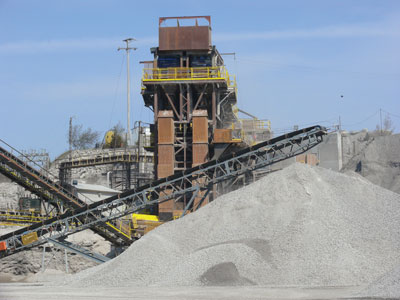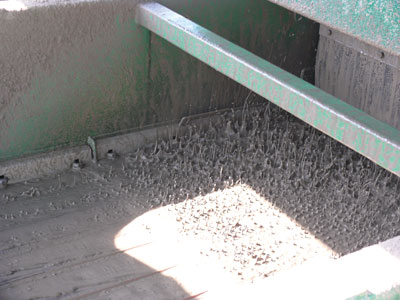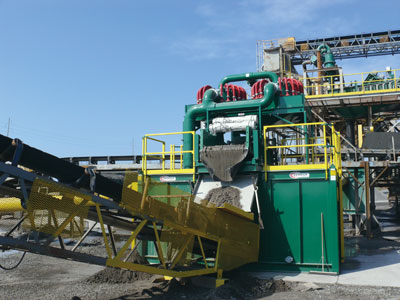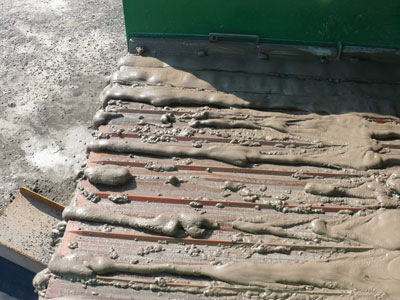
Features
Aggregates
Technology
Finding Savings in Fines Recovery
How Port Colborne Quarries spent to save.
June 15, 2012 By Andrew Macklin
The staff at Port Colborne Quarries was tired of cleaning out their settling ponds year after year.
The staff at Port Colborne Quarries was tired of cleaning out their settling ponds year after year. Like many other aggregate operations of their size, having to pull workers and equipment away from daily operations to clean out the ponds was a terrible use of their limited resources.
 |
|
| The PCQ crushing operation includes several units, making multiple sizes of aggregate for use in Rankin Construction projects.
|
But thanks to a smart infrastructure decision, and a company willing to invest in its own operations, it was only a matter of time before much of that problem was eliminated.
Originally opened by Canada Steamship Lines in the 1950s, the quarry was later sold to the Ontario Stone Corporation in Cleveland, Ohio. Rankin Construction then purchased PCQ in 2007 to help provide aggregate for its construction and paving operations. Before Rankin took over, 90% of the aggregate produced at the Port Colborne Quarry was shipped to the U.S. That has changed dramatically with the purchase by Rankin, as now 100% of the aggregate is staying in Canada. The materials are now used in Rankin’s road-based material products in its asphalt plant, as well as for concrete and piping applications.
After completing the purchase, Rankin then conducted a full review of the equipment inventory, and purchased a series of equipment upgrades to help meet the demands of its operation.
The equipment upgrades started with the replacement of the outdated crushing equipment being used. Rankin purchased a pair of NP1315 Impact Crushers from Metso, as well as one of Metso’s C140 Jaw Crushers. The new crushers would allow the Quarry to produce several different sizes of aggregates at the same time. With multiple aggregate sizes being produced, the company also needed new stackers to transport the materials, leading to the purchase of 11 of North Star Equipment’s 36-inch x 100-foot units.
The remaining need for the quarry’s operation was a wash plant for making sand. The decision was made by Rankin officials to turn to Derrick Corporation for that purchase, whose head office is in nearby Buffalo, N.Y. Derrick Corporation’s product applications engineer Donald Ruppert became involved in the deal, and provided PCQ with some advice about its infrastructure overhaul.
“Through talking with Don, we knew about the next stage,” said Tim Cassibo, operations manager at Port Colborne Quarries. “So we had it in our minds that, two or three years down the road, we’d tack on the next end of the system to recover some of the material that was going into the settling pond.”
Even more fines
With a significant increase in its annual aggregate extraction, the residual ultra fines began to clog the settling ponds that much quicker. PCQ was facing the need to devote manpower and resources to cleaning twice a year, only to recover a product that had no current usage.
 |
|
| Water is separated from the ultra fines material before being dried and stacked.
|
|
 |
|
| The Derrick HI-G Dryer Fines Recovery System is small in stature compared to the Derrick wash plant seen behind it.
|
But with the help of Don Ruppert from Derrick, the infrastructure was in place to make room for ultra fines recovery.
“In late 2011, we looked at what was going in to our settling ponds and what we were having to take out,” said Cassibo. “We had to recapture that material to keep it out of the settling ponds.”
Rankin went to Grant Aggregate and Industrial Supply, the Canadian distributor for Derrick out of Ajax, Ont., to find out what products were available to tackle its fines recovery issue. The recommendation was the HI-G Dryer Fines Recovery System.
The ultra fines system would allow the company to convey the materials left after screening for manufactured sand, with the end result being a stackable product rather than fill for the settling ponds. And based on the company’s prior experience with Derrick, PCQ was happy to once again give its business to both Grant and Derrick.
“The technical support they have, being able to get Don over to sit him down and tell him what we want. That makes a big difference,” said Cassibo. “He told us what he could give us, we made some minor changes to the system based on where some of the inlets and outlets went, and Derrick manufactured the system the way we wanted it.”
The adjustments made by Derrick for Port Colborne Quarries did not affect the function levels. That has allowed PCQ to get the full functionality of the HI-G system without any losses from customizing the operation to its own specifications.
“The Derrick four-inch (102-millimetre) ceramic hydrocyclones mounted on our unique radial designed manifold provide an excellent recovery or cut point down to the 500 mesh level; this stage of the process is what allows the Derrick unit to provide the highest recovery possible,” says Ruppert of the new Derrick system. “With the fine material now extracted prior to the settling pond, it now reports to the Derrick high G force dewatering screen. This screen outfitted with the Derrick patented high open area urethane screen surfaces dewaters the ultra fines to a dryness level of 80% solids, with no free running water present.”
Fast install
Port Colborne Quarries took delivery of the HI-G Dryer Fines Recovery System in late March. Within half a day, the company had the three main components up, the tanks, screen and cyclone banks, with piping and tying everything together taking an additional day. The efficiency of the setup meant that representatives from Derrick, Grant Aggregates, and Port Colborne Quarries could all be present to work together to address any issues during installation.
 |
|
| The solid material as it comes out of the HI-G dryer before dropping to the conveyor for stacking.
|
|
 |
|
| Aggregate from Port Colborne Quarries goes to support Rankin Construction’s building projects, such as the expansion of Highway 406 south of Welland.
|
With no major difficulties during the installation process, Port Colborne Quarries was able to get the HI-G system operational just a few short days after the unit arrived. It didn’t take long for the crew at PCQ to realize the effectiveness of the machine. The ultra fines material was quickly becoming a solid pile of usable product below the conveyor. At the settling pond, Tim ran his hand under the pipe where water gushed out from the ultra fines operation. As the water drained from his hand, there was almost no trace of any solid product remaining.
That usable product has several different applications, such as agricultural line material, mineral fillers and use in some granular products at low percentages. While the product has found some uses in the Rankin Construction operations, there is the potential to generate a new source of revenue through the external sale of the ultra fines.
Derrick has published that the HI-G Fines Recovery System will recover up to 80% of the solids currently reporting to an operation’s settling pond. In the early stages of the ultra fines system’s operation at Port Colborne Quarries, the recovered percentage of ultra fines has been 69.5%. That efficiency would lead to a four to five times greater life for an existing settling pond, a cost savings that Port Colborne Quarries factored in when balancing the costs of purchasing and installing the unit versus consistent cleaning of the settling pond.
“We know there will be a cost savings for our operation,” said Cassibo. “What we will have now is a salable product in a dry form, instead of an unusable product taken from the ponds. Hopefully, it will also mean that we can go from cleaning our settling pond once a year to once every three or four years.”
Print this page